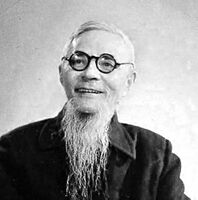Zikai, F.: Difference between revisions
(Created page with "{{Person |pagename=Zikai, F. |MainNamePhon=Feng Zikai |SortName=Zikai, Feng |namefirst=Feng |namelast=Zikai |MainNameTib=豐子愷 |bio=Feng Zikai (simplified Chinese: 丰子...") |
No edit summary |
||
| Line 1: | Line 1: | ||
{{Person | {{Person | ||
|MainNamePhon=Feng Zikai | |MainNamePhon=Feng Zikai | ||
|SortName=Zikai, Feng | |SortName=Zikai, Feng | ||
| Line 7: | Line 6: | ||
|MainNameTib=豐子愷 | |MainNameTib=豐子愷 | ||
|bio=Feng Zikai (simplified Chinese: 丰子恺; traditional Chinese: 豐子愷; pinyin: Fēng Zǐkǎi; November 9, 1898 – September 15, 1975) was an influential Chinese painter, pioneering manhua (漫画) artist, essayist, and lay Buddhist of 20th-century China. Born just after the First Sino-Japanese War and dying just before the end of the Cultural Revolution, he lived through much of the political and socioeconomic turmoil during the birth of modern China. Much of his literary and artistic work comments on and records the relationship between the changing political landscape and ordinary people's daily lives. Although most famous for his paintings depicting children and the multi-volume collection of Buddhist-inspired art ''Paintings for the Preservation of Life'' (护生画集), Feng was a prolific artist, writer, and intellectual who made strides in the fields of music, art, literature, philosophy, and translation. ([https://en.wikipedia.org/wiki/Feng_Zikai Source Accessed July 21, 2023]) | |bio=Feng Zikai (simplified Chinese: 丰子恺; traditional Chinese: 豐子愷; pinyin: Fēng Zǐkǎi; November 9, 1898 – September 15, 1975) was an influential Chinese painter, pioneering manhua (漫画) artist, essayist, and lay Buddhist of 20th-century China. Born just after the First Sino-Japanese War and dying just before the end of the Cultural Revolution, he lived through much of the political and socioeconomic turmoil during the birth of modern China. Much of his literary and artistic work comments on and records the relationship between the changing political landscape and ordinary people's daily lives. Although most famous for his paintings depicting children and the multi-volume collection of Buddhist-inspired art ''Paintings for the Preservation of Life'' (护生画集), Feng was a prolific artist, writer, and intellectual who made strides in the fields of music, art, literature, philosophy, and translation. ([https://en.wikipedia.org/wiki/Feng_Zikai Source Accessed July 21, 2023]) | ||
|images=File:Zikai Feng-hk epoch times.jpg | |||
|yearbirth=1898 | |yearbirth=1898 | ||
|yeardeath=1975 | |yeardeath=1975 | ||
|pagename=Zikai, F. | |||
}} | }} | ||
Latest revision as of 18:08, 21 July 2023
| FirstName / namefirst | Feng |
|---|---|
| LastName / namelast | Zikai |
| MainNamePhon | Feng Zikai |
| MainNameTib | 豐子愷 |
| SortName | Zikai, Feng |
| bio | Feng Zikai (simplified Chinese: 丰子恺; traditional Chinese: 豐子愷; pinyin: Fēng Zǐkǎi; November 9, 1898 – September 15, 1975) was an influential Chinese painter, pioneering manhua (漫画) artist, essayist, and lay Buddhist of 20th-century China. Born just after the First Sino-Japanese War and dying just before the end of the Cultural Revolution, he lived through much of the political and socioeconomic turmoil during the birth of modern China. Much of his literary and artistic work comments on and records the relationship between the changing political landscape and ordinary people's daily lives. Although most famous for his paintings depicting children and the multi-volume collection of Buddhist-inspired art Paintings for the Preservation of Life (护生画集), Feng was a prolific artist, writer, and intellectual who made strides in the fields of music, art, literature, philosophy, and translation. (Source Accessed July 21, 2023) |
| YearBirth | 1898 |
| YearDeath | 1975 |
| Other wikis |
If the page does not yet exist on the remote wiki, you can paste the tag |

